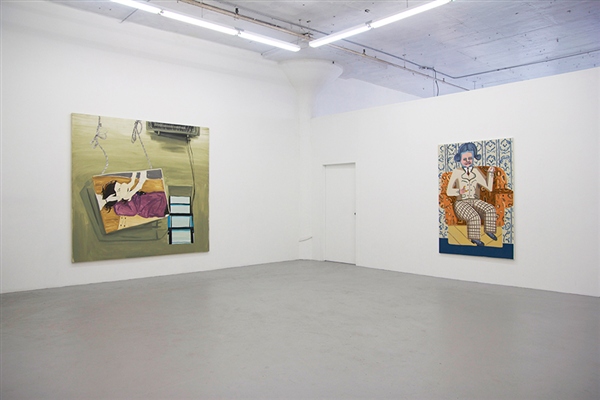Regina Rex’s summer show Four Paintings doesn’t label itself as a curated show, but it’s one of the more well-thought out shows I’ve seen this summer. This will be the second time the collective has offered a summer show in this format; last year’s Four Paintings show was similarly phenomenal.
I attribute the show’s quality to its zero-sum game principle. With this iteration of Four Paintings: Picture Window, all works were of a similar scale, color palette, and subject matter (women). In addition to the subject matter, all the artists (Hannah Barrett, Linda Gallagher, Becky Kinder and Summer Wheat) are women.
This principle ends up feeling like a trick, and left me wondering if all the paintings were meant to be the same. Sameness isn’t a great quality in art, though; it’s difficult to say what’s good or bad when it’s all alike. So I spent a fair amount of time trying to figure out if these four paintings had a lot or a little to do with each other.
Maybe the best painting in the show just so happened to feature an actual window in it, making it seem like a good curatorial fit for the show. Linda Gallagher’s Selma (2009), an oddly staged painting-within-a-painting, shows a painting of boxed-in-woman being lowered by ropes (maybe), under an air conditioner (maybe), into a window (maybe) in which she can’t possibly fit. There are several trompe l’oeil holes in this painting to keep the work interesting—it’s a simple device to keep the eye wandering. The holes add to the work’s mystery, but there’s not so many to be overbearing.
There’s something about this painting that made me queasy, in addition to the portals and the range of motion, and it probably has to do with the puke-colored palette. The muddied color ranges from swamp green to pea green, and dusky purple to clay purple. That physical discomfort isn’t bad; it distances me from the painting, as it’s definitely not a window into a world I’d want to be.
Hannah Barrett’s Small Brown One, a cartoony, androgynous portrait of a pudgy, blue-faced, sitter squatting against a couch, provides a peek into a more fantastical, Victorian-inspired world. Like Gallagher’s painting, there’s an air of mystery to the scene. Who is this blue-faced person, and should I even care to figure that out? Honestly, one of the reasons why I kept on looking, and cared to figure that out, was the painting’s busy patterning. These patterns fill-in the painting’s larger shapes(the loveseat, wall paper, and clothing). For instance, the chevrons in the loveseat fit neatly to the edges of the seat, as do the grids that fan across the sitter’s pants legs.That might not be the most exciting reason to like a painting, but I appreciated the decoration’s purposefulness.
In the other paintings, it’s less interesting to figure out “how” elements fit together; for the most part, there’s not enough going on, visually. What we do get are plenty of overly familiar elements, which makes looking at these paintings pretty boring.
There’s Summer Wheat’s Scratchpad, featuring a masturbating girl who seems very American Apparel with her striped, track star socks. Chunks of paint, like glopped on eyeballs, that don’t add much to the painting other than to demarcate space. Becky Kinder’s Untitled, while less cluttered, suffers from a similar problem of familiarity; the two fetal-like heads immediately brought to mind that Rolling Stones album cover, and the drips seemed to function too much like blood, lending the work a Freudian vibe. It’s not a terrible painting, but there’s nothing really standout here.
Despite first appearances, and shared formal concerns, maybe none of these paintings have much in common after all: Gallagher’s is one part emo to Barrett’s Monty Python, and Summer Wheat’s grotesque girl has nothing to do with Kinder’s psychedelic psychology.
That’s a strange conclusion to draw from a group show without faulting the curation, but there seems little reason to do so. While it may not have been in the intent of Regina Rex, it’s nice to see a show of all-female painters with an interest in figuration and formalism, and conclude that they’re pretty different.



{ 2 comments }
Sameness is a great quality in art. It’s the only quality that allows for difference.
I’m confused how blue plus blue equals red, but I’m happy to hear how that works.
Comments on this entry are closed.